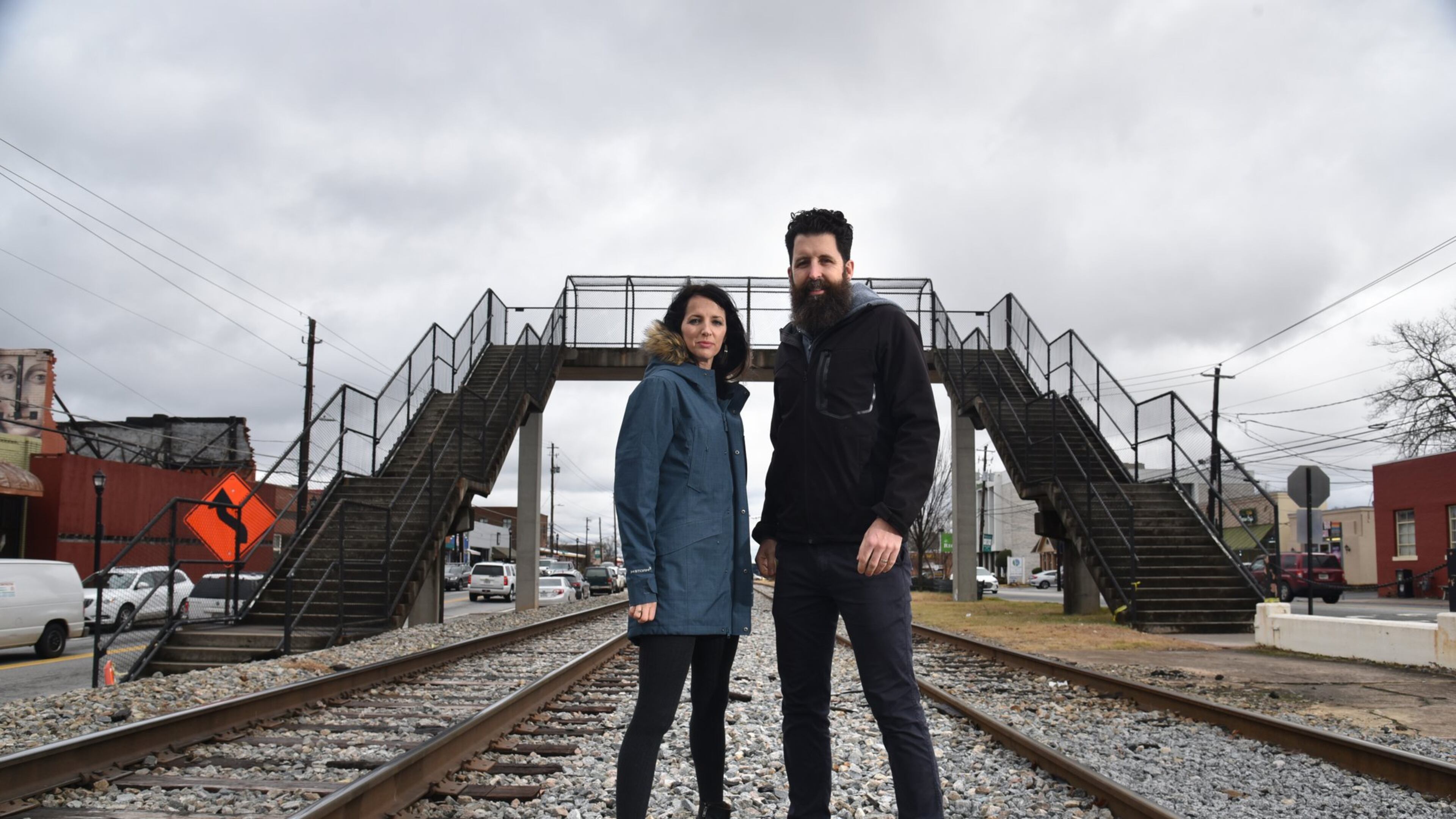Husband and wife artists help transform Southside art scene

When it comes to Atlanta art power couples, Whitney and Micah Stansell are in a league of their own, and they're about to put their stamp on the city of Hapeville in a very big way.
Highly sought after by local curators and gallery owners, the artists’ ambitious, collaborative — and mostly temporary — artworks marry Micah’s interest in new materials and technology with Whitney’s boundless visual imagination.
Separately, but mostly together, the long-married pair, who live with their three young children in a 1928 bungalow in College Park, have achieved some significant career milestones. In their 2012 video and audio installation “The Water and the Blood” at the High Museum of Art, they projected — like a highbrow drive-in movie — a romance-drenched story founded on Stansell family history onto the buildings surrounding Sifly Piazza.
In 2013 they won the Tequila Herradura Barrel Art Collection competition, which came with a $100,000 prize. They used the money to turn the house next door into a studio and rental property. That same year, they created "An Inversion with Sky" for Flux Night, a one-night-only extravaganza of curated art installations in a public space. Placed in a narrow alleyway in the Castleberry Hill neighborhood, the piece featured 3,000 sheets of paper suspended between two buildings and fluttering in the wind, onto which video of daytime skies was projected. It was a dreamy, magical crowd-pleaser that showed the couple's signature blend of technical prowess and poetic effect.

Now comes an important landmark project for the couple. After years of making evanescent work that disappeared after just one night, they are creating their first permanent public art work. This new project also offers them a chance to make an indelible impact in the Tri-Cities triad of East Point, College Park and Hapeville, where they have functioned as unofficial boosters and where Micah’s family has lived for decades.
Whitney, 39, and Micah, 40, are the winners of a $45,000 commission and national artist call to transform a pedestrian bridge in Hapeville into a public art experience. It is, according to the artists’ concept, “experiential and immersive,” and a billboard for the small, often overlooked city.
The Hapeville Pedestrian Bridge is also the chance to resuscitate what even locals admit has “long been regarded by many as an eyesore in the community,” says David Burt, an economic development consultant for Hapeville who helped spearhead the initiative, which included hiring curatorial group Dashboard to produce the project.
“So many clever people applied,” says Dashboard co-founder and executive director Beth Malone of a search that yielded proposals from across the country, including New York, Detroit and Los Angeles.
The Stansells were determined to tackle the project when they first heard about it because it was, Micah says, “right in our backyard.” The couple has often worked to highlight the quirky, lost-in-time appeal of the area that can feel dwarfed by metro Atlanta’s wildfire growth. The bridge project was a chance to take something frumpy and spit-shine it into a thing of beauty. The grim, cage-like metal bridge located in the center of town was constructed to give residents a safe way to cross the train tracks that runs along North Central Avenue.

“One thing we’ve observed about the bridge is no one uses,” says Micah. “So our idea is that (by) putting in a permanent public piece of art, it becomes a destination. It becomes a place for you to go and experience the space.”
The bridge will feature a “Hapeville” sign that will light up at night, and a mesh roof featuring an LED display of changing lights and images. In addition, thousands of aluminum disks will cover the bridge surface, where they will shimmer and move in the breeze much like those undulating pieces of paper in “An Inversion with Sky.”
“The disks turn the bridge into a giant kinetic sculpture that reacts to and reflects the environment around it,” says Micah. Instead of a grim, rarely used thoroughfare, the bridge in the Stansell’s hands will become a welcoming invitation to engage with the city’s architecture.
“We hope it will become a kind of beacon in a way. It is meant to be experienced by making the effort to climb the stairs and spend some time at the top,” says Micah.
The bridge, which will be completed in spring 2019, has provided the Stansells with an opportunity to create an artistic legacy after building a reputation for impermanent art works.
“As wonderful as these ephemeral, short-run things are,” says Micah, “they take a lot out of you for that amount of time.”
“It’s also heartbreaking when so many people come up to you and say, ‘Gosh I was out of town, so sorry I didn’t get to see it’,” adds Whitney.
The bridge is also a big deal for Hapeville. Located in the epicenter of a growing downtown, it will represent a gentrifying community’s desire to highlight the arts and artists.
“These people, especially the city government, these people really care,” says Whitney, of those who helped make the project happen. “These people are really invested in Hapeville.”
The bridge is part of the city’s Blueprint 2020, which has the goal of making Hapeville “Metro Atlanta’s arts community, where artists can live, work and share their art,” says economic development consultant David Burt, who drafted the plan in 2012. It includes creating public art, arts programming, gallery space and eventually affordable housing and studio space for artists.
“I’ve been so impressed with (Hapeville’s) commitment to the arts and how they play a vital role in economic growth and community building,” says Dashboard’s Malone, who has spearheaded several gallery crawls for the city.
“We like our community,” says Micah. “We like old things. I think our work truly is very much about our community and loving and taking care of things.”

